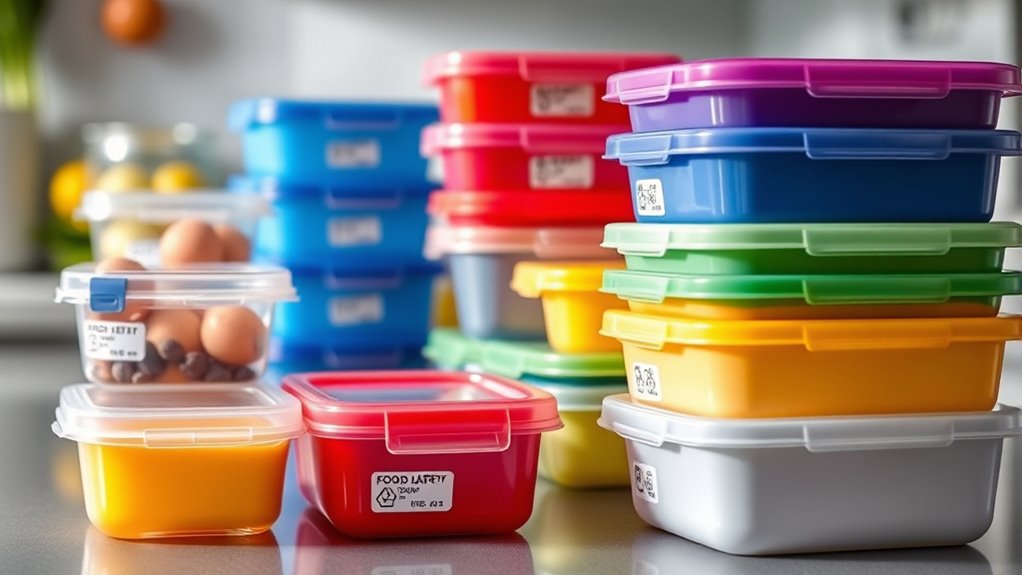To guarantee your plastics are safe for food, look for labels with recycling codes 1 (PETE) and 2 (HDPE), and always check for food-safe symbols like a fork and glass. Avoid plastics marked with codes like 3 (PVC) or 7, which may leach harmful chemicals. Properly store, reuse, and handle plastics carefully, and consider alternatives like glass or silicone. If you want to understand the full details, you’ll find essential tips and safety advice that can help protect your health.
Key Takeaways
- Always check recycling codes, especially #1 (PETE) and #2 (HDPE), for food safety suitability.
- Avoid heating or reusing plastics labeled with #3 (PVC) or #7 (Other) due to potential chemical leaching.
- Use food-grade plastics and verify microwave-safe labels to prevent chemical migration during heating.
- Properly clean, dry, and store plastics in cool, dark places to extend lifespan and reduce contamination risks.
- Consider glass or silicone alternatives for long-term, safe food storage, reducing plastic degradation and chemical exposure.
Understanding the Different Types of Food Plastics
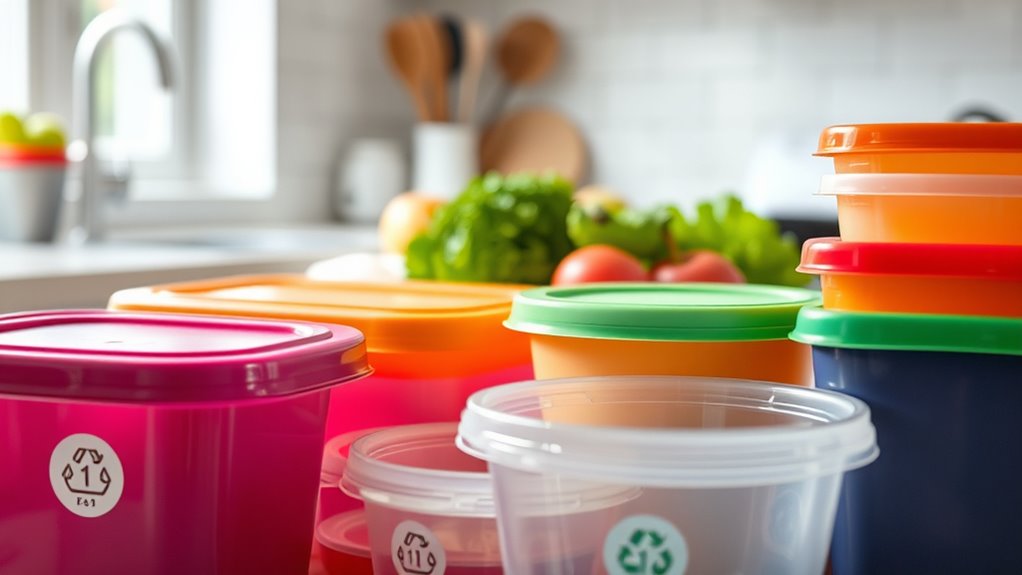
Understanding the different types of food plastics is essential for guaranteeing your food stays safe and uncontaminated. Knowing which plastics are safe for food contact helps prevent chemical leaching and health risks. Some plastics, like PET (Polyethylene Terephthalate), are widely used for bottles and are considered safe for single use, but they aren’t recommended for recycling or reuse. Others, like HDPE (High-Density Polyethylene), are more durable and suitable for food storage, and they’re often recyclable. Being aware of plastic recycling codes helps you identify which plastics are food safe and which should be avoided. Recognizing Vetted brands and products can also ensure higher quality and safety standards. By understanding these distinctions, you can make smarter choices, reduce waste, and ensure your food remains uncontaminated during storage and handling.
Recognizing Food Safe Plastic Labels and Symbols
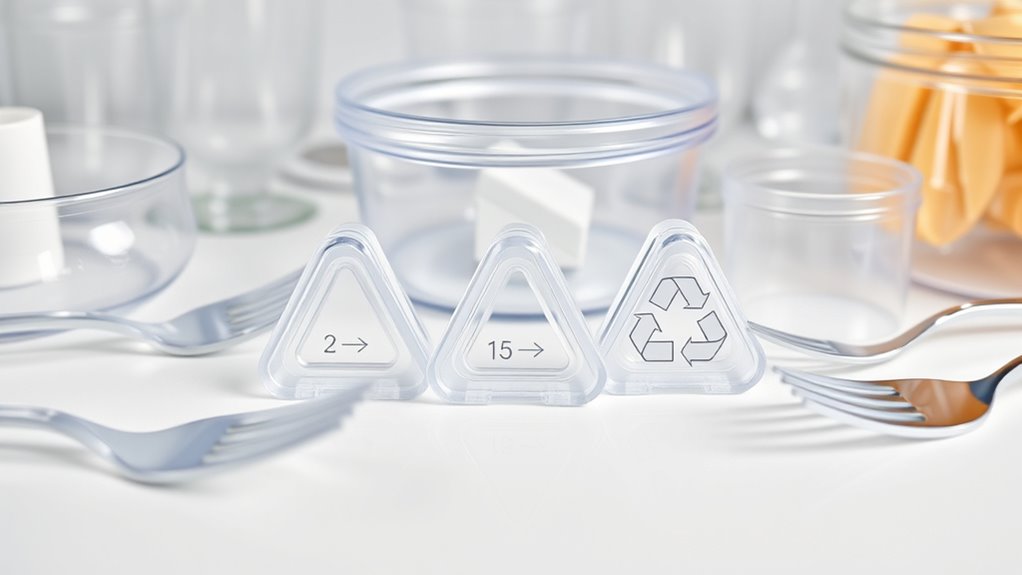
Recognizing food safe plastic labels and symbols is key to assure the containers you use are suitable for food contact. Look for recycling codes, typically a number inside a triangle of arrows, which indicate the type of plastic and its safety for food storage. Labels like “3” (PVC) or “7” (Other) may require caution, while “1” (PETE) and “2” (HDPE) are generally considered safer. Familiarize yourself with labeling standards to identify food-safe plastics quickly. Many containers also display symbols like a fork and glass, indicating food safety. Proper recognition helps you avoid plastics that may leach harmful chemicals into your food. Understanding these labels ensures you’re making informed choices based on plastic recycling codes and safety standards. Additionally, being aware of food safe plastics can help prevent contamination and ensure the longevity of your food storage solutions.
Common Myths About Plastic Safety in the Kitchen
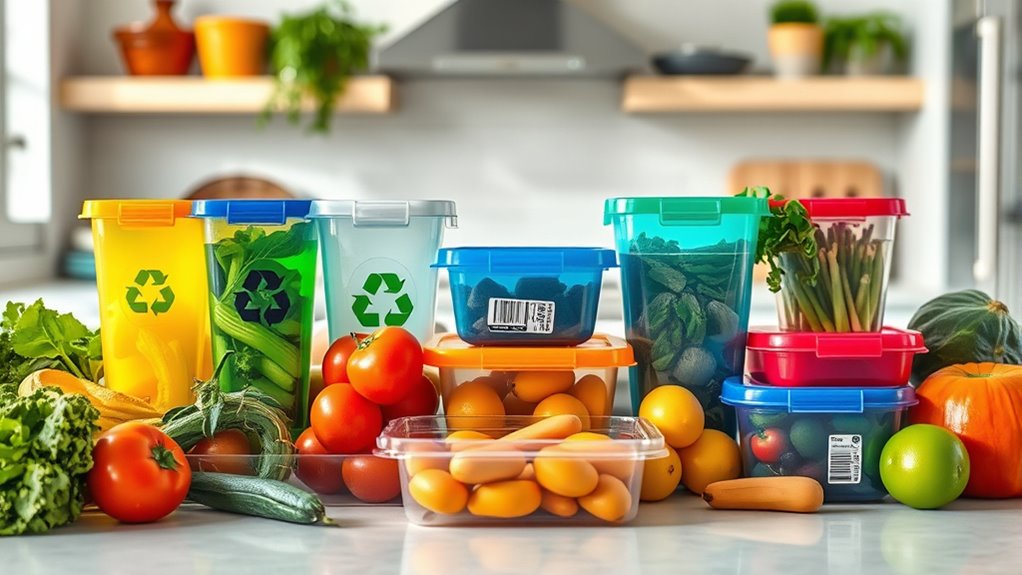
Many people assume that if a plastic container is labeled as food safe, it’s completely risk-free, but that’s a common misconception. Myth busting reveals that food safe plastics can still degrade over time or with improper use, releasing harmful chemicals. Safety misconceptions also include believing plastics are only risky when heated, but some plastics leach chemicals even at room temperature. Additionally, some think all plastics are identical, ignoring differences in chemical composition and durability. Lastly, many underestimate the importance of replacing old or scratched plastics, which can harbor bacteria or release toxins. Understanding these myths helps you make smarter choices in the kitchen. Recognize that food safe doesn’t mean risk-free forever—constant vigilance and proper care are key to safe plastic use. Color accuracy and contrast ratio are also important factors to consider for ensuring the safety and quality of plastics used in food packaging and storage.
The Risks of Using Non-Food Grade Plastics

Using non-food grade plastics can expose you to chemical leaching, which might contaminate your food over time. These plastics often aren’t designed to withstand repeated use, leading to durability issues and potential breakage. Ignoring these risks can pose long-term health concerns you shouldn’t overlook. Additionally, choosing food-safe plastics can help reduce exposure to harmful substances and promote safer food storage practices.
Chemical Leaching Concerns
Have you ever wondered what might be lurking in your plastic containers? Chemical leaching occurs when chemicals from non-food grade plastics migrate into your food or drinks, increasing toxin exposure. This process, called chemical migration, can happen when plastics are exposed to heat, acidity, or prolonged storage. Using plastics not labeled as food safe raises the risk of ingesting harmful substances like BPA, phthalates, or other additives. These toxins can interfere with hormones and pose health risks over time. To protect yourself, avoid heating or storing food in plastics without proper certification. Being aware of these risks helps you make smarter choices for your kitchen safety.
- Non-food grade plastics often contain harmful chemicals
- Heat accelerates chemical migration
- Acidic foods increase toxin exposure
- Proper labeling indicates safer plastic options
- Food safe plastics are designed to minimize chemical migration and keep your food safe.
Long-Term Health Risks
When you consistently use non-food grade plastics, you risk exposing yourself to harmful chemicals that can accumulate in your body over time. This long-term exposure can negatively impact your plastics health, as certain chemicals like BPA or phthalates may leach out, especially with repeated use or heat. Over months or years, these substances can interfere with hormone levels, disrupt endocrine functions, and increase your risk of health issues such as reproductive problems or cancers. The danger isn’t immediate, but the cumulative effect of these chemicals can be significant. Avoiding non-food grade plastics and choosing safe alternatives minimizes the risk of long-term health complications. Prioritizing food-safe plastics helps protect your well-being and ensures safer storage and handling of your food. Track development techniques can help manufacturers improve the safety and effectiveness of plastics used in food packaging.
Plastic Durability Issues
While choosing non-food grade plastics may seem convenient, their durability often falls short, posing risks during storage and reuse. These plastics can undergo plastic degradation over time, weakening their structure and increasing the chance of failure. Low tensile strength means they’re more prone to cracking, warping, or breaking under stress. This not only compromises the container’s integrity but can also lead to chemical leaching, contaminating your food. Additionally, exposure to heat or UV light accelerates degradation, further reducing durability. Using plastics with poor durability can result in leaks, spills, or the release of harmful substances. To avoid these issues, always opt for food-safe plastics designed to withstand typical kitchen conditions and maintain their strength over time. Plastic durability issues are compounded by environmental factors, making it essential to choose high-quality, food-grade plastics for safety and longevity.
How to Properly Store and Reuse Plastic Containers
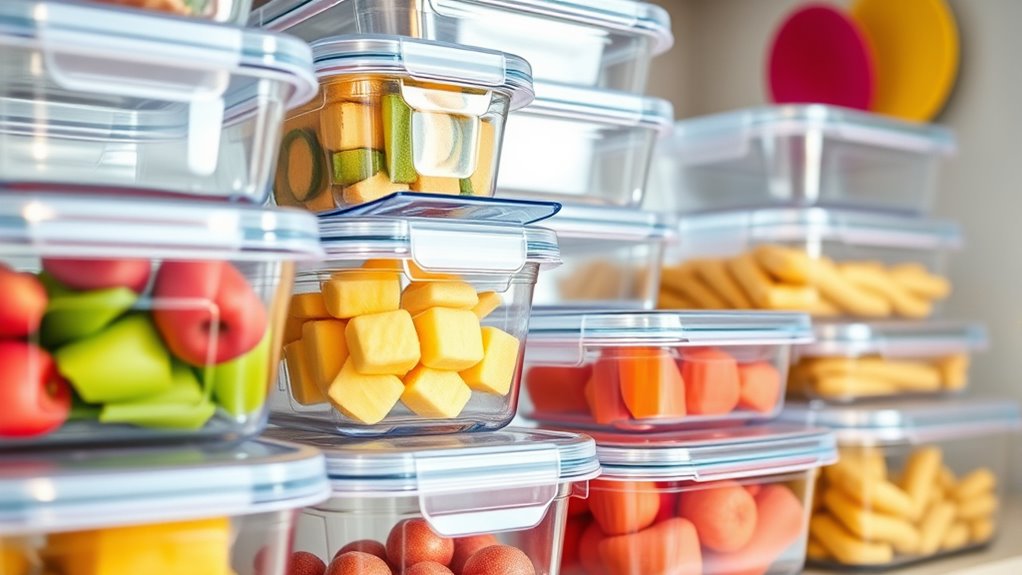
Properly storing and reusing plastic containers helps guarantee your food stays fresh and safe. Always check the container labeling for recycling symbols and safe use guidelines. Use containers designated for food storage, and avoid reusing those not labeled as food-safe, especially if they previously held non-food substances. Clean containers thoroughly with hot, soapy water and ensure they’re completely dry before refilling. Store containers in a cool, dry place away from direct sunlight to prevent degradation. If you plan to recycle plastic, follow your local recycling program’s instructions and separate plastics by type. Reusing containers thoughtfully reduces waste and extends their lifespan, but always prioritize safety by verifying their suitability for reuse and proper cleaning. Additionally, UV filters in some containers can help protect your food from sunlight damage during storage.
Best Practices for Heating and Cooling Plastics Safely
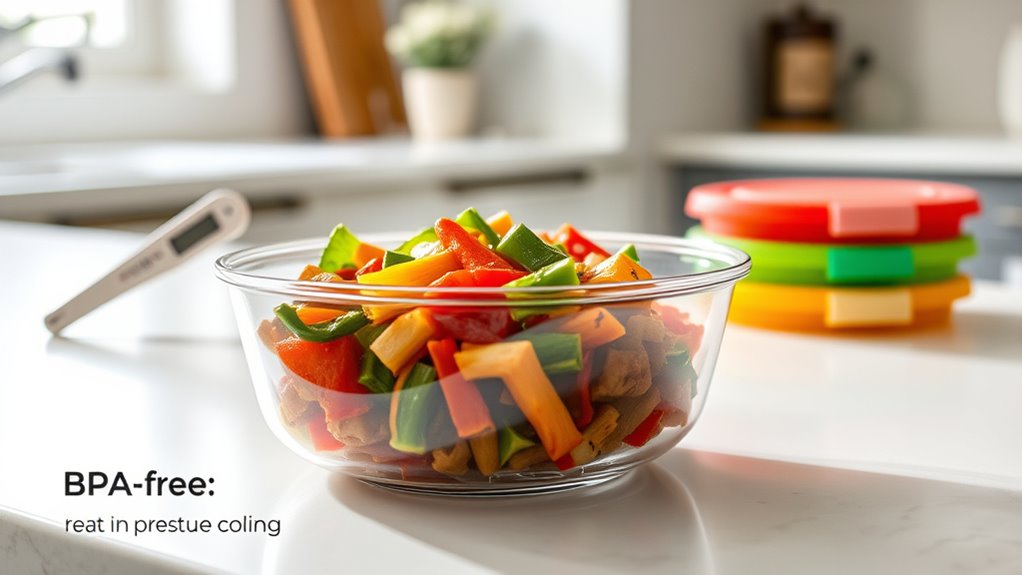
When heating or cooling plastics, always look for microwave-safe labels to prevent hazards. Avoid rapid temperature changes, which can cause warping or cracking, and follow the manufacturer’s instructions carefully. These simple steps help guarantee your plastics stay safe and in good condition during use. Incorporating proper techniques in your handling can further enhance safety and prolong the lifespan of your plastic items.
Use Microwave-Safe Labels
Using microwave-safe labels on plastic containers is vital for guaranteeing safe heating and cooling. These labels help you quickly identify plastics suitable for microwave use, reducing the risk of melting or chemical leaching. Always check for the microwave safe labels before heating your food to avoid accidents. Proper plastic identification ensures you’re using the right containers and preserves your health. Keep in mind that even labeled plastics can degrade over time, so inspect containers regularly. When in doubt, transfer food to glass or ceramic dishes. Remember, relying on plastic identification and microwave safe labels is a simple but essential step in safe kitchen practices.
- Confirm labels before microwaving
- Understand what the symbols indicate
- Inspect containers for damage or wear
- Use reliable sources for plastic identification
Avoid Rapid Temperature Changes
Sudden temperature changes can weaken plastic containers and increase the risk of warping or cracking. Rapid shifts cause uneven thermal expansion, stressing the material and leading to brittle fractures. To prevent damage, avoid transferring plastics directly between hot and cold environments. Instead, let containers cool gradually or warm up slowly. This careful handling preserves the integrity of the plastic and prevents costly failures.
| Temperature Change | Recommended Action | Why It Matters |
|---|---|---|
| Hot to Cold | Cool gradually | Prevents brittle fractures |
| Cold to Hot | Warm slowly | Reduces thermal stress |
| Reheating | Use medium heat | Ensures even expansion |
| Cooling After Heating | Air or room temperature | Avoids sudden stress |
Follow Manufacturer Instructions
Following manufacturer instructions is key to heating and cooling plastics safely. Ignoring guidelines can cause plastics to warp, release harmful chemicals, or compromise food safety. Always check that your plastic container is microwave or dishwasher safe before heating. Proper use helps prevent the release of food additives into your meals and supports responsible plastic recycling at the end of its life. When heating, avoid exceeding recommended temperatures to prevent melting or deformation. Cooling should be gradual to avoid stress fractures. Remember, some plastics are not suitable for repeated heating or freezing. By following instructions, you ensure safe handling and prolong the lifespan of your plastics. This practice also minimizes environmental impact, supporting safer plastic recycling and reducing potential chemical migration into food. Additionally, understanding the properties of food safe plastics can help you select the best containers for your needs and ensure ongoing safety.
Alternatives to Plastic for Food Storage and Preparation
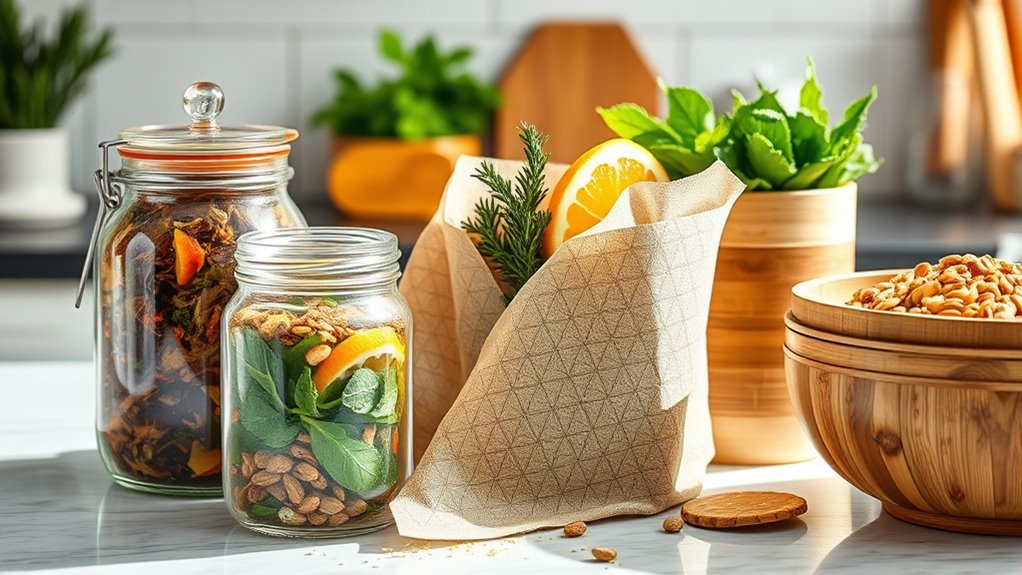
Are there safer and more sustainable options than plastic for storing and preparing food? Absolutely. Reusable silicone containers are a versatile choice—they’re durable, heat-resistant, and free from harmful chemicals. You can microwave, freeze, and store food without worries. Glass storage options are another excellent alternative; they’re non-porous, don’t stain or retain odors, and are easy to clean. Plus, glass is recyclable and often lasts a lifetime, making it eco-friendly. Both options eliminate the risks associated with plastic leaching chemicals into your food. Moving to reusable silicone and glass storage not only protects your health but also reduces plastic waste. These alternatives are practical, safe, and better for the environment, giving you peace of mind with every meal prep and storage.
Tips for Identifying and Avoiding Harmful Plastic Chemicals
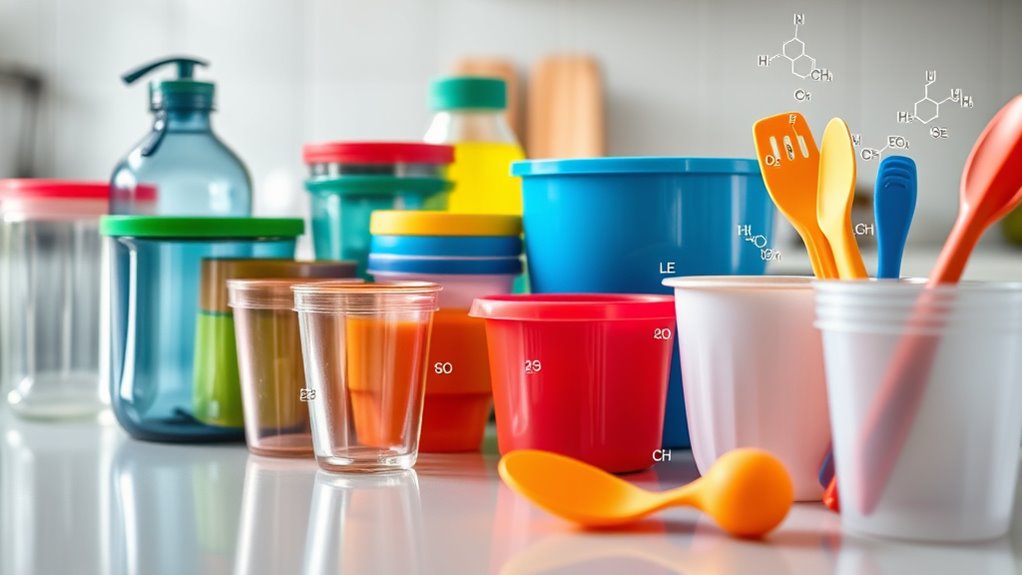
Switching to safer storage options like glass and silicone helps reduce exposure to harmful chemicals, but it’s also important to recognize and avoid toxic substances that can lurk in plastics. To identify risky plastics, check recycling codes—look for numbers 1, 2, and 5, which generally contain safer materials. Be wary of plastic recycling labels with code 3 (PVC) and 7 (other), which often include harmful chemical additives like BPA and phthalates. Always read labels for warnings about chemicals or additives. Consider avoiding plastics that are scratched or cracked, as damage can increase chemical leaching. Additionally, research brands committed to non-toxic, BPA-free plastics, and stay informed about the latest findings on plastic recycling safety and chemical additives.
The Environmental Impact of Plastic Use in Food Storage
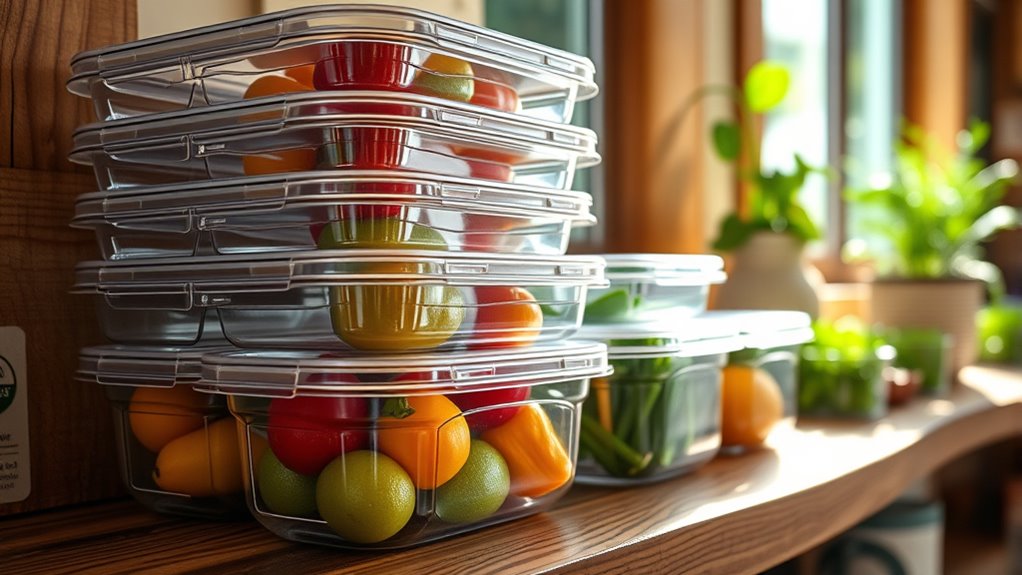
Plastic use in food storage has a significant environmental footprint, contributing to pollution and resource depletion. When single-use plastics and improperly disposed containers end up in landfills or oceans, they lead to plastic pollution that harms wildlife and ecosystems. Manufacturing plastics consumes vast amounts of fossil fuels, driving environmental degradation through greenhouse gas emissions and habitat destruction. Over time, plastics break down into microplastics, contaminating soil and water sources. This persistent pollution affects marine life, birds, and even human health through the food chain. Reducing plastic waste is vital to minimizing these impacts. By choosing reusable containers and avoiding unnecessary plastic packaging, you can help lessen environmental degradation and protect our planet for future generations.
Making Informed Choices: Choosing the Right Plastics for Your Home
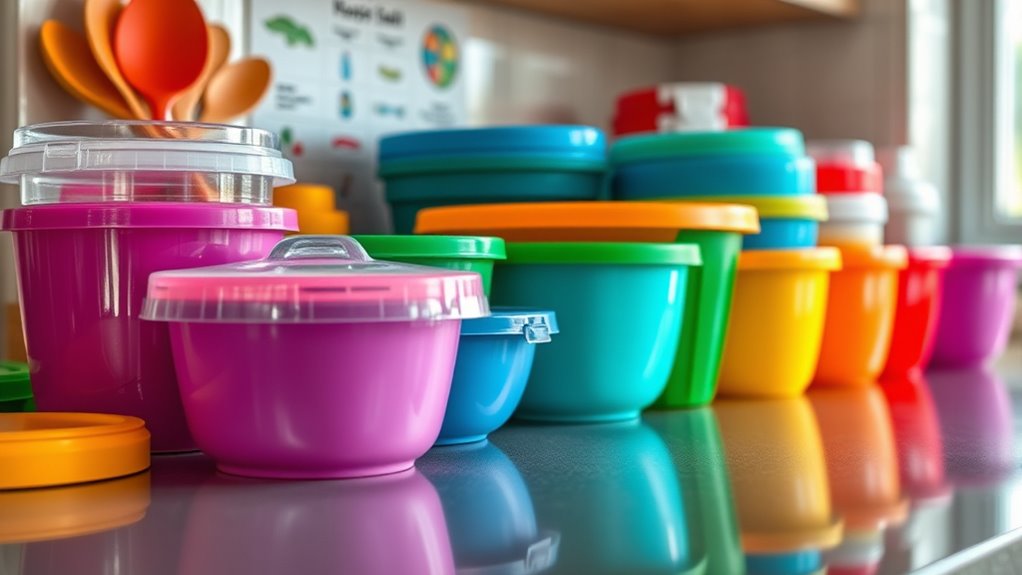
Choosing the right plastics for your home can considerably reduce your environmental footprint while ensuring food safety. To make informed decisions, consider the types of plastics used in food packaging and their recyclability. Look for plastics labeled with recycling codes that indicate safer options, such as #1 (PET) or #5 (PP). Avoid plastics containing BPA or other harmful chemicals. Being aware of plastic recycling practices helps you select products that are environmentally friendly and easier to dispose of responsibly.
- Check recycling symbols to identify plastics suitable for food contact
- Choose plastics that are easily recyclable in your local area
- Avoid single-use plastics that contribute to waste
- Opt for durable, reusable containers when possible
Frequently Asked Questions
Are All Plastics Labeled as Bpa-Free Completely Safe for Food Contact?
Not all plastics labeled BPA-free are completely safe for food contact. While they avoid BPA, some plastics still undergo recycling processes that can introduce other chemicals, increasing the risk of chemical leaching into your food. Always check for additional safety labels and avoid reusing plastics not designed for repeated food contact. Opt for plastics marked specifically as food-grade to minimize exposure to potentially harmful chemicals and guarantee safety.
Can Heating Plastic Containers Release Harmful Toxins Into My Food?
Heating plastic containers can be like revealing hidden secrets—chemical leaching may occur, releasing toxins into your food. When you crank up the temperature, the plastic’s defenses weaken, making it easier for harmful chemicals to escape. To protect yourself, avoid microwaving plastics not labeled as microwave-safe. Keep things cool and safe, because high heat turns ordinary plastics into potential villains in your kitchen story.
How Can I Tell if My Plastic Storage Is Still Safe to Use?
You can tell if your plastic storage is still safe by checking for signs of plastic degradation, like cloudiness, warping, or cracks. If it’s been used beyond its recommended storage lifespan or shows damage, it’s best to substitute it. Over time, plastics break down and may leach harmful substances, so regularly inspecting and replacing your containers helps ensure food safety. When in doubt, opt for newer, BPA-free options.
Do Plastic Numbers Indicate the Safety Level for All Food Types?
Did you know that over 60% of plastic recycling involves plastics not always safe for food contact? The numbers on plastics help identify their type but don’t guarantee safety for all food types. Certain plastics may contain chemicals that leach into your food, especially when heated. Always check for specific food-safe symbols or labels instead of relying solely on the recycling number to prevent chemical leaching.
Are Biodegradable Plastics Safe for Long-Term Food Storage?
Biodegradable plastics can be safe for short-term food storage, but they’re not ideal for long-term use. They’re designed as biodegradable packaging, which means they break down faster and may not provide the same durability as traditional plastics. Plus, their environmental impact is positive, but their stability over time isn’t guaranteed. For long-term storage, stick with proven food-safe plastics to make certain your food stays fresh and safe.
Conclusion
By choosing the right plastics and understanding their labels, you can protect your health and the environment. Did you know that over 300 million tons of plastic are produced globally each year, with much ending up in our oceans and food chain? Being informed helps you make safer choices in your kitchen. Small changes, like avoiding non-food grade plastics, can make a big difference for your well-being and the planet’s future.

